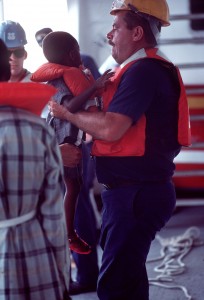Oral History and Guantánamo
National Dialogue and Traveling Exhibit | Reflection + Action

Off the coast of Haiti (June 30)–BM1 Tom Stanford helps a young Haitian boy into a RHI (rigid hull inflatable) boat on the Coast Guard Cutter Dauntless (WMEC 624) as the refugees are sent back to Haiti. USCG photo by PA2 David M. Santos
Guantánamo is about people. Mired in the languages of the War on Terror, and
previous to that, of relief efforts and military operations, it is a fact easily obscured.
Guantánamo has been variously discussed as a ‘detainment centre,’ a ‘prison,’
a ‘military base,’ a ‘camp,’ one full of ‘detainees,’ ‘prisoners,’ ‘refugees,’ ‘soldiers,’ with
a sprinkling of civilians, residents, base workers.
For the past several months, I have been trying to find oral history interview candidates
who can illuminate the long and varied history of Guantánamo Bay, Cuba, in its
numerous stages, who can flesh out what life was like in this particular corner of the
world and witnessed its unusual developments. Much of my research has necessarily
been done online. Pursuing this kind of research rests in large part on the crossed-finger
hope that people have some web presence that we can latch onto, whether through
online directories, past interviews, newspaper profiles, social media networks and
associations. We’ve also had to roll the dice on word of mouth in the hopes of getting to
these far-reaching and extended networks of friends, colleagues, voluntary associations,
anything. These are leaps of faith that may often turn nothing up.
But slowly, these elusive stories have begun to materialize, greeting me usually in my
inbox as they seemingly appear from the so-called woodwork of the past half-century
or more. They are stories of family, school, daily life, adventure, adolescence, fear,
duty, refuge, hope, hopelessness, generosity, exile, friendship, memory, bravery,
disappointment, joy, defiance, challenge, gratitude, frustration, anger, patience. Above
all, through these various missives are ringing the voices of deep personal engagement
with Guantánamo’s history and of rich human experiences that form, colour, and shape
a place we think we know. It has been an exciting and humbling process to witness,
one that has come pulsating to life because we asked. If you could stop and ask: What
are the stories that surround you, that you witness, every day? How can you and those
around you contribute to all of us understanding Guantánamo?
If you have a story of Guantánamo to share, we want to hear from you. Please email us
at guantanamo@columbia.edu.
Melissa Garcia is a Researcher and the Oral Histories Coordinator for the Guantánamo Public Memory Project. She holds an MA from Columbia University and an MSc from the London School of Economics.
